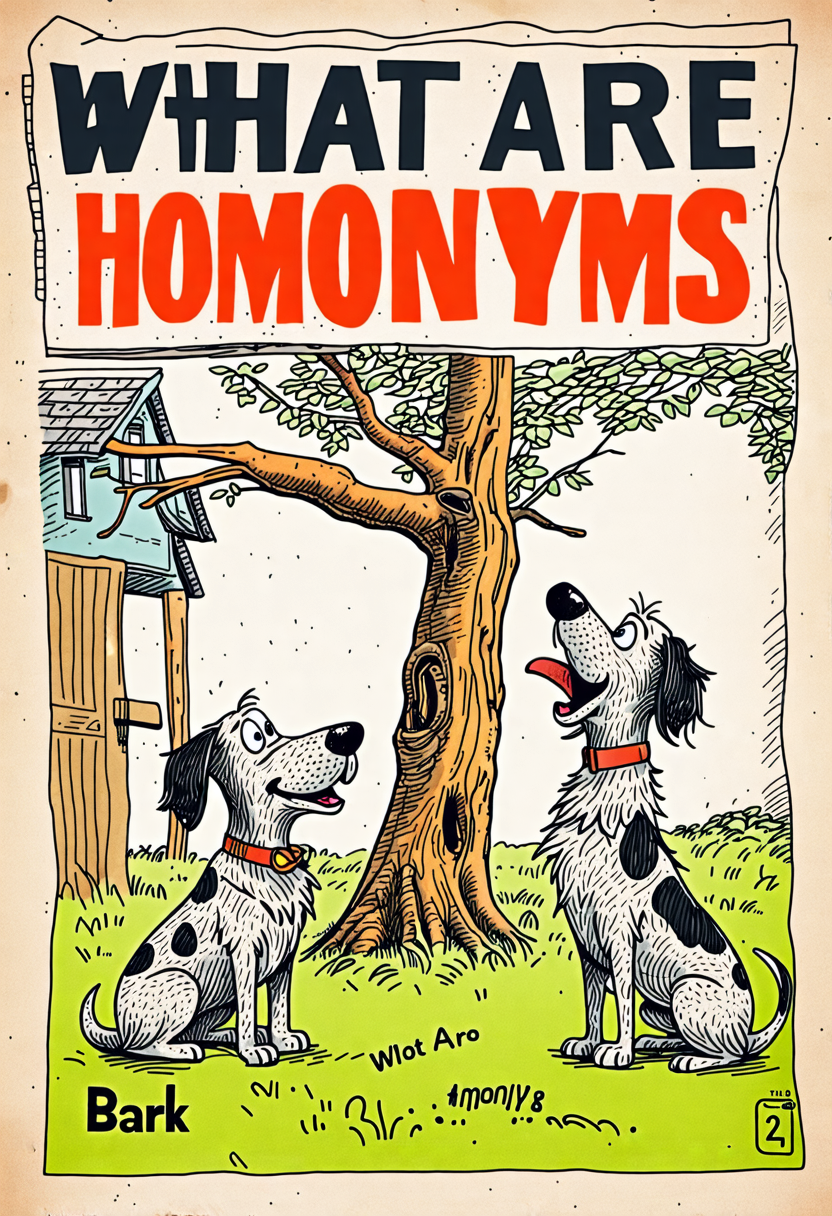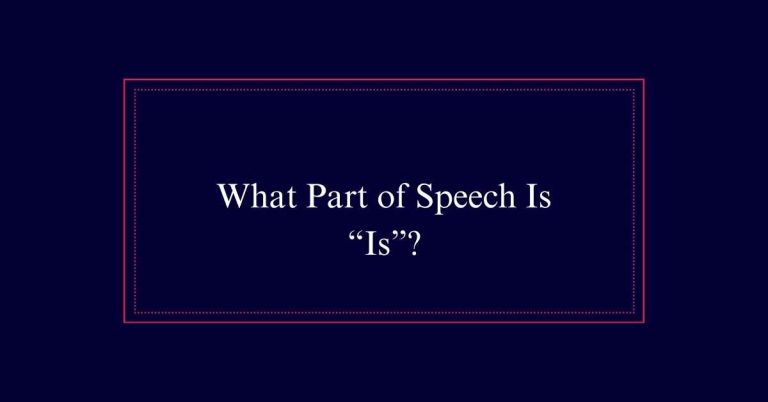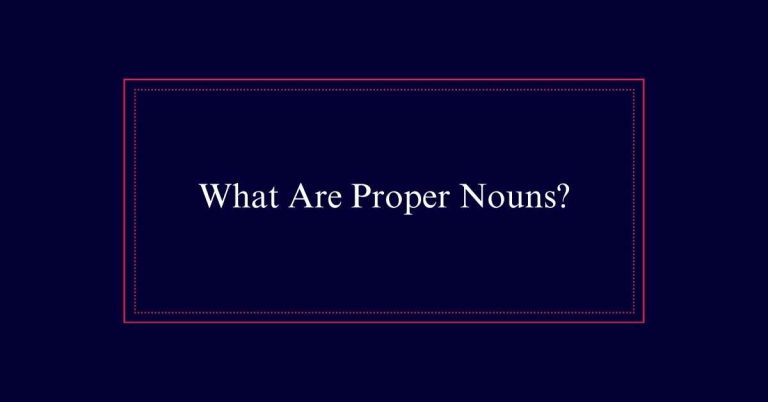What are Homonyms?
Homonyms are words that share the same spelling or sound but have different meanings. They are categorized into homophones and homographs. Homophones sound the same but may have different spellings and meanings, such as “to,” “too,” and “two.” Homographs are spelled the same but have different meanings and sometimes different pronunciations, like “lead” (a metal) and “lead” (to guide).
What Are Homonyms?
Understanding homonyms begins with recognizing that they are words with the same spelling or sound but different meanings.
Homonyms can be divided into two main categories: homophones and homographs.
Homophones are words that sound the same but have different meanings, such as ‘flower’ and ‘flour.’
Homographs are words that are spelled the same but have different meanings, like ‘lead’ (to guide) and ‘lead’ (a type of metal).
Homonyms serve as an umbrella term for both homophones and homographs. They are essential in language because they add richness and complexity.
Homonyms Vs. Homophones
While homonyms encompass both homophones and homographs, it is important to distinguish between these two categories.
Homophones are words that sound the same but have different meanings and spellings. For example, ‘flower’ and ‘flour’ are homophones; they are pronounced identically but have entirely different meanings and spellings.
On the other hand, homographs are words that share the same spelling but differ in meaning and sometimes pronunciation. For instance, ‘lead’ (to guide) and ‘lead’ (a type of metal) are homographs.
Homonyms Vs. Homographs
How do homonyms and homographs differ, and why is understanding this distinction important?
Homonyms are words that share the same spelling or pronunciation but have different meanings. Homographs, a subset of homonyms, are specifically words that are spelled the same but have different meanings. For example, ‘lead’ (a type of metal) and ‘lead’ (to guide) are homographs.
Understanding this distinction is vital for clear communication. Misinterpreting these words can lead to confusion.
For writers, precise use of homographs guarantees the intended meaning is conveyed. Additionally, recognizing homographs helps in learning vocabulary and understanding nuances in language.
Categorizing Homonyms
Categorizing homonyms involves distinguishing between homophones and homographs, each with unique characteristics. Homophones are words that sound the same but have different meanings and spellings. For example, ‘flower’ and ‘flour’ are homophones.
Homographs, on the other hand, are words that are spelled the same but have different meanings and may have different pronunciations. An example of a homograph is ‘lead,’ which can mean a type of metal or to guide.
Homonyms serve as an umbrella term that includes both homophones and homographs.
Using Homonyms in Writing
Using homonyms in writing can add depth and creativity to your work. They allow writers to craft engaging wordplay, puns, and double entendres, enriching the text.
For instance, using homophones like ‘flower’ and ‘flour’ can introduce humor or a twist in meaning. Homographs like ‘lead’ (to guide) and ‘lead’ (the metal) can add layers to your sentences.

However, it is essential to provide clear context to prevent reader confusion. Carefully chosen homonyms can make your writing more dynamic and enjoyable.
They can also evoke curiosity, prompting readers to think more deeply about your words. When used effectively, homonyms enhance the reader’s experience and showcase the writer’s linguistic skill.
Contextual Clarity With Homonyms
Ensuring contextual clarity with homonyms is essential to avoid confusing the reader. Since homonyms share the same spelling or pronunciation but have different meanings, it is important to provide enough context.
Here are some strategies to enhance clarity:
- Sentence Structure: Use clear and straightforward sentences to define the context.
- Additional Descriptions: Add descriptive words or phrases to specify the meaning.
- Examples: Provide examples that clearly differentiate the meanings of homonyms.
- Avoid Ambiguity: Refrain from using homonyms in ways that could lead to misunderstandings.
Wordplay and Puns With Homonyms
Wordplay and puns with homonyms can add humor and wit to writing, making it more engaging for readers. Writers often use homonyms to create clever jokes and playful sentences. This technique relies on words that sound alike but have different meanings, sparking amusement through unexpected twists.
Here’s a table illustrating common homonyms used in puns:
| Homonym Pair | Example Sentence | Explanation |
|---|---|---|
| Flour/Flower | “Bakers need flour power.” | Flour (ingredient) vs. flower (plant) |
| Write/Right | “Writers always want to be right.” | Write (compose) vs. right (correct) |
| Sea/See | “Can you sea the difference?” | Sea (ocean) vs. see (observe) |
Apostrophes in Homonyms
While wordplay with homonyms can be entertaining, it’s important to pay attention to apostrophes in homonyms to maintain clarity in writing. Apostrophes can greatly alter meanings, especially with homonyms that involve contractions or possessives. Misplacing an apostrophe can confuse readers and obscure the intended message.
Here are four key points to keep in mind:
Contractions:
Words like ‘they’re’ (they are) vs. ‘their’ (possessive form).
Possessives:
‘It’s’ (it is) vs. ‘its’ (belonging to it).
Plurals:
Avoid adding apostrophes to make plurals (e.g., ‘cats’ not ‘cat’s’).
Context:
Make sure the sentence context supports the correct homonym usage.
Famous Homonym Examples
Many famous works of literature incorporate homonyms to add depth and humor. For instance, in Shakespeare’s ‘Romeo and Juliet,’ the word ‘grave’ is used both to mean serious and as a reference to a burial place.
Another example is found in Oscar Wilde’s ‘The Importance of Being Earnest,’ where the name ‘Ernest’ is a homophone for ‘earnest,’ meaning sincere. These plays showcase how homonyms can add layers of meaning and wit.
Additionally, in ‘Alice’s Adventures in Wonderland’ by Lewis Carroll, homonyms are used for playful wordplay, such as ‘tortoise’ and ‘taught us.’
Enhancing Writing With Homonyms
By leveraging the intrinsic ambiguity of homonyms, writers can craft more engaging and nuanced narratives. Homonyms add layers of meaning and complexity to writing, making it more intriguing for readers.
Here are four ways to enhance writing using homonyms:
- Create Wordplay and Puns: Use homonyms for playful effects, adding humor and wit.
- Develop Rich Descriptions: Employ homonyms to provide multiple interpretations of a scene or character.
- Add Depth to Dialogue: Characters using homonyms can introduce subtle irony or misunderstanding.
- Engage Readers: Homonyms can prompt readers to think critically, deciphering the intended meaning.







